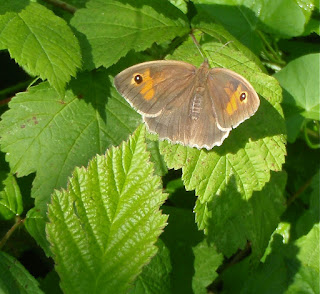The survey for 29th July 29th 2021 revealed butterflies and dragonflies outnumbering birds, not unusual for high summer. This is of course what is seen and heard which is not indicative of what is actually present along the river.
It was windy and sunny, with a few clouds scudding across, The breeze was cool, from the south-west and the ground damp underfoot, with large puddles and good numbers of insects over the water. Grasses going to seed have been delayed this year due to the cold spring but Goldfinches were now happy with seedheads appearing, at least in sunny areas. The river was quite high with mud indicating that levels had been at least 0.5 meters higher. Comparing the presence of fruit now more visible on the trees, it was clear that some had been exposed to freezing winds, hail and late frosts when in blossom whilst most had escaped and were producing strong fruits. This depends each year on the timing of the different varieties coming into blossom and the location of the trees on banks and slopes. As with the the fruit trees, there are different varieties of Bramble and each hedge or clump was at a different stage of producing blossom and fruits. with instant attention from bees and butterflies. There was a good selection of grasses and wild flowers, with Knapweed, Thistles, Meadowsweet, Fleabane, Willowherbs, Vetch, Clovers, Seneecio jacobaea, Bird's Foot Trefoil and many more.
Fleabane has done exceptionally well this year, suddenly flowering after a few hot and damp days:
A Hoverfly on rain-battered Fleabane which attracts many butterflies.
This time the survey begins with butterflies: over 100 Gatekeepers were seen, chasing, being chased by other species, along hedges and over grasses, nectaring on many of the wild flowers, rather late this year.
One Brimstone female was present and over 30 Large White and 4 Small White butterflies were seen, most in flight.
Two Comma butterflies were present in different areas, and only two Meadow Browns but 9 Ringlets in damper areas. Two Holly Blues and one Small Blue were flying near one of the ponds with a single Speckled Wood in the shade. Four Red Admiral butterflies were on thistles near one of the drainage basins, one of them chased off by an aggressive Gatekeeper.
Above - a female Meadow Brown butterfly in a faded condition having survived torrential rain. wind and sun. The upper sides are usually darker when young. The low number seen may be due to the Meadow Brown butterfly sometimes roosting in the tops of trees and being exposed to this summer's bad weather.
Note that there were several Marbled White butterflies in the same area in mid July first seen here last summer 2020. It's good to observe that they have reappeared this year!
Next, Dragonflies:
One strong-flying Brown Hawker, a Large Red Damselfly and three Migrant Hawkers were present
and very active.
The most numerous by far were the Banded Demoiselle Damselflies, many in the shelter of the steep Arun river banks typically in the area shown in the photo on the previous post.
It was interesting to see several males clinging upside-down on different levels on a single reed peering onto the water surface below. More were perched on a tree log, coming and going, dashing out for passing insects.
Grasshoppers:
Largely unseen unless disturbed were hundreds of small Meadow Grasshoppers low down in the thick layers of the grasses on the river bank meadow, jumping to the top then falling back down under cover.
Bees of many types, Bumblebees and Honey bees were numerous as were Hoverflies.
Birds
Most numerous by far were the Goldfinches, more than 60, which were heard then seen in several groups, some flying across and landing in trees and thickets, where they would sing together, juveniles included. Along the river, Blue Ts (19 )and Great Ts (5) were moving amongst the trees mostly selecting insects as they went, a few calling. A call from a single Willow warbler was heard (not the song) and more than 20 Chiffchaffs were heard calling and most seen, making continuous contact with others. Perhaps they were forming flocks before migrating, although some will be overwintering here locally.
They are usually the first migrant birds to arrive here in the spring. A single Whitethroat was seen amongst the branches of a young tree.
Blackbirds and Song Thrushes had been late to commence their spring song this year but made up for in volume but have been very quiet during their moult season, only uttering alarm calls. Only 13 Blackbirds were seen and no song thrushes.
One or two were 'sunning' on the bramble verge while some were obviously still feeding young.
Usually the most numerous of birds heard singing along the river - the wrens were remaining very quiet - only 6 were heard or seen. Even fewer Robins were counted - three, they have not left but are in hiding still.
Three Blackcaps were visible in the thickets over the Arun where they are usually seen when they first arrive in the spring and are heard singing. They will probably leave soon, to be replaced with 'winter Blackcaps'-it is still thought that the birds that are seen here in the winter are not summer migrants which have decided to remain rather than migrate.
We have all seen large flocks of House Sparrows about but only 23 were seen today, quite vocal, but well hidden in the hedges. Starling numbers can vary a lot but 6 were counted and only three Herring Gulls seen flying across. 27 Woodpigeons were scattered in old oak trees and on the grass under them . There were 4 Magpies, 5 (moulting) Carrion Crows and one Jay in the same trees.
Finally a single Great Spotted woodpecker and two calling Nuthatches were seen.
There were signs of early plundering of Hawthorn berries and Hazel nuts neither being fully ripe at the time, but very plentiful.






